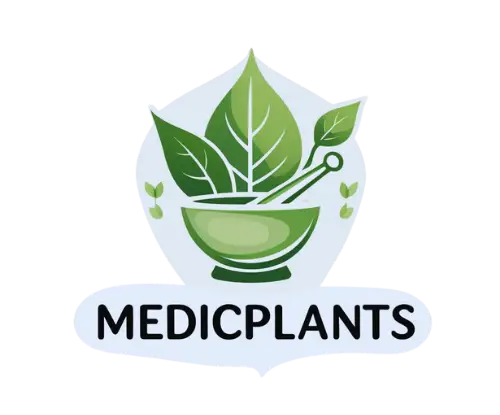The Vasaka plant (Justicia adhatoda), affectionately referred to as the Malabar nut, is a green marvel that blossoms at the centre of old Ayurvedic wisdom. This unassuming shrub has been used for ages to perform silent miracles, particularly in the areas of lung clearance and breath relaxation.
Today’s modern lives and the thickening of city air with smoke, dust, and allergens make Vasaka more than just a herb; it’s a natural respiratory health barrier. Vasaka is nature’s tried-and-true ally, whether you’re fighting a chronic cough, having trouble breathing, or just wanting to breathe cleaner and deeper.
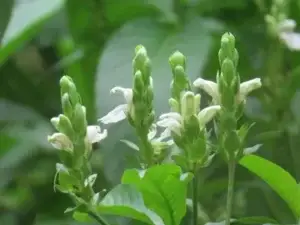
1. What is the Vasaka plant?
Justicia adhatoda, the scientific name for the Vasaka plant, is a potent medicinal shrub indigenous to Southeast Asia and the Indian subcontinent. For millennia, ancient medicinal systems such as Ayurveda, Unani, and Siddha have held it in high regard due to its exceptional capacity to promote respiratory health.
Little white or purple tubular flowers and rich, dark green, lance-shaped leaves make this evergreen shrub easy to identify. Beyond its aesthetic appeal, however, is a powerful botanical force. The plant’s leaves, blossoms, roots, and bark all have strong therapeutic qualities.
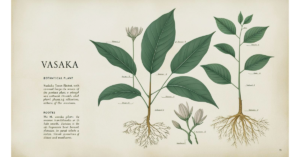
Vasicine, a naturally occurring alkaloid with demonstrated expectorant, bronchodilatory, and anti-inflammatory properties, is the active ingredient that gives Vasaka its real magic. Because of these qualities, it is a popular treatment for ailments like asthma, chronic bronchitis, and common colds and coughs.
Vasaka is a reliable herbal ally in promoting clear lungs, easy breathing, and general respiratory health, regardless of whether it is consumed as a tea, syrup, capsule, or herbal paste.
2. Traditional Uses of Vasaka in Ayurveda
The herb Vasaka (Justicia adhatoda), also referred to as Vasa, has long been prized in Ayurvedic medicine for its potent respiratory-related effects. Vasaka is renowned for balancing the Pitta and Kapha doshas because to its heating (Ushna) intensity and bitter (Tikta) and astringent (Kashaya) flavour. Because of these qualities, it works particularly well to reduce mucus production, calm irritated airways, and ease dyspnoea. Its functions are described in Ayurvedic classics as Raktastambhaka (managing internal bleeding), Kaphahara (removing mucus), Kasahara (easing cough), and Shwasahara (alleviating dyspnoea). Asthma, bronchitis, sore throats, hoarseness, acute and chronic coughs, and even bleeding diseases like haemoptysis have all been treated with it for ages.
A staple of traditional Ayurvedic treatments, Vasaka is used in herbal teas or decoctions derived from its leaves, Vasavaleha (a herbal jam for cough and asthma), and Vasa Ghrita (ghee infused with Vasaka for internal inflammation). To increase its potency, it is frequently combined with herbs that work well together, such as ginger, tulsi, mulethi, and pippali. Vasaka is still a natural and comprehensive treatment for preserving good respiratory health, and it is particularly used in the damp and colder seasons.

3. Key Health Benefits of the Vasaka Plant
The respiratory system is one of the many health advantages that the Vasaka plant provides. Vasicine, an active ingredient found in its leaves, has been shown to have bronchodilator, expectorant, and anti-inflammatory effects. Because of this,Vasaka is particularly good in reducing coughing, removing mucus from the lungs, and making it easier to breathe while suffering from bronchitis or asthma. It eases inflamed airways, lessens chest congestion, and dilates the bronchial tubes.Because of its haemostatic (bleeding control) properties, Vasaka is known to help treat bleeding disorders like haemoptysis (coughing up blood) in addition to its respiratory advantages. By aiding the body in the battle against respiratory infections, it also strengthens the immune system. According to certain traditional usage, when combined with other herbs in the right amounts, it may help with fevers, skin disorders, and digestive issues. All things considered, Vasaka is regarded as a complete treatment that not only alleviates symptoms but also supports the body’s innate capacity to recover and preserve lung health.
Because of this,Vasaka is particularly good in reducing coughing, removing mucus from the lungs, and making it easier to breathe while suffering from bronchitis or asthma. It eases inflamed airways, lessens chest congestion, and dilates the bronchial tubes.Because of its haemostatic (bleeding control) properties, Vasaka is known to help treat bleeding disorders like haemoptysis (coughing up blood) in addition to its respiratory advantages. By aiding the body in the battle against respiratory infections, it also strengthens the immune system. According to certain traditional usage, when combined with other herbs in the right amounts, it may help with fevers, skin disorders, and digestive issues. All things considered, Vasaka is regarded as a complete treatment that not only alleviates symptoms but also supports the body’s innate capacity to recover and preserve lung health.
4. Scientific Research & Studies on Vasaka
The traditional applications of the Vasaka plant (Justicia adhatoda) for respiratory health have been more and more supported by contemporary scientific studies. According to studies, the main alkaloids that give it its strong bronchodilator, expectorant, and anti-inflammatory properties are vasicine and vasicinone. Vasaka extracts have been demonstrated in laboratory and clinical trials to considerably increase airway clearance, lessen bronchial inflammation, and facilitate breathing in patients with bronchitis and asthma.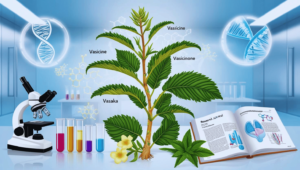
Studies that have been published in journals like the Journal of Ethnopharmacology and Phytotherapy Research demonstrate how well Vasaka works to improve lung function and suppress the cough reflex without having negative side effects. Studies have looked at its antioxidant, antibacterial, and anti-tubercular properties in addition to its respiratory support, making it a potentially useful natural remedy for inflammation and respiratory infections. These results open the door for the herb’s incorporation into contemporary herbal formulations and respiratory care supplements, in addition to confirming its long-standing use in Ayurveda.
5. How to Use Vasaka Safely
It is necessary to comprehend the appropriate dosage, preparation techniques, and individual suitability of Vasaka in order to use it safely. Vasaka is traditionally ingested in a variety of ways, including avaleha (herbal jam), ghee preparations (Vasa Ghrita), powder (churna), syrups, and herbal teas (decoctions).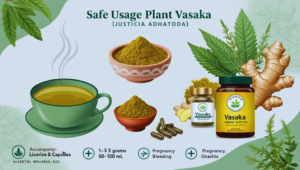
While decoctions are frequently taken in quantities of 50 to 100 ml, depending on the formulation’s potency and condition, adults typically take 1 to 3 grammes of Vasaka leaf powder daily.
It is best taken under an Ayurvedic practitioner’s supervision, particularly for people with bleeding disorders, chronic illnesses, or pregnancy.
Vasaka is typically harmless, however because of its potent bioactive ingredients, such as vasicine, excessive use may cause stomach discomfort or disrupt blood coagulation. It should be used carefully by those who have ulcers or low platelet counts. It is advised to avoid long-term unsupervised usage of Vasaka and to combine it with balancing herbs like ginger or liquorice (mulethi) to ensure safety and efficacy. Like other powerful herbs, the secret to maximising its therapeutic benefits without experiencing negative side effects is moderation and appropriate instruction.
